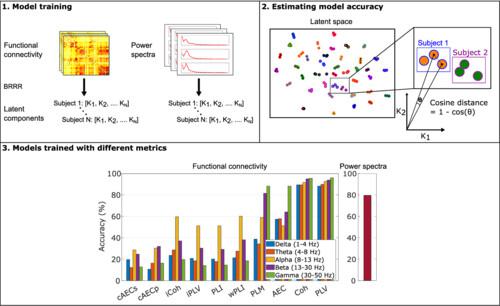当前位置:
X-MOL 学术
›
Eur. J. Nerosci.
›
论文详情
Our official English website, www.x-mol.net, welcomes your feedback! (Note: you will need to create a separate account there.)
Bayesian reduced rank regression models generalizable neural fingerprints that differentiate between individuals in magnetoencephalography data
European Journal of Neroscience ( IF 3.4 ) Pub Date : 2024-03-14 , DOI: 10.1111/ejn.16292 Joonas Haakana 1 , Susanne Merz 1 , Samuel Kaski 2 , Hanna Renvall 1, 3 , Riitta Salmelin 1
European Journal of Neroscience ( IF 3.4 ) Pub Date : 2024-03-14 , DOI: 10.1111/ejn.16292 Joonas Haakana 1 , Susanne Merz 1 , Samuel Kaski 2 , Hanna Renvall 1, 3 , Riitta Salmelin 1
Affiliation

|
Recent magnetoencephalography (MEG) studies have reported that functional connectivity (FC) and power spectra can be used as neural fingerprints in differentiating individuals. Such studies have mainly used correlations between measurement sessions to distinguish individuals from each other. However, it has remained unclear whether such correlations might reflect a more generalizable principle of individually distinctive brain patterns. Here, we evaluated a machine‐learning based approach, termed latent‐noise Bayesian reduced rank regression (BRRR) as a means of modelling individual differences in the resting‐state MEG data of the Human Connectome Project (HCP), using FC and power spectra as neural features. First, we verified that BRRR could model and reproduce the differences between metrics that correlation‐based fingerprinting yields. We trained BRRR models to distinguish individuals based on data from one measurement and used the models to identify subsequent measurement sessions of those same individuals. The best performing BRRR models, using only 20 spatiospectral components, were able to identify subjects across measurement sessions with over 90% accuracy, approaching the highest correlation‐based accuracies. Using cross‐validation, we then determined whether that BRRR model could generalize to unseen subjects, successfully classifying the measurement sessions of novel individuals with over 80% accuracy. The results demonstrate that individual neurofunctional differences can be reliably extracted from MEG data with a low‐dimensional predictive model and that the model is able to classify novel subjects.
中文翻译:

贝叶斯降序回归模型可概括神经指纹,区分脑磁图数据中的个体
最近的脑磁图(MEG)研究报告称,功能连接(FC)和功率谱可以用作区分个体的神经指纹。此类研究主要利用测量会话之间的相关性来区分个体。然而,目前尚不清楚这种相关性是否反映了个体独特的大脑模式的更普遍的原则。在这里,我们评估了一种基于机器学习的方法,称为潜在噪声贝叶斯降序回归 (BRRR),作为使用 FC 和功率谱对人类连接组计划 (HCP) 静息态 MEG 数据中的个体差异进行建模的方法作为神经特征。首先,我们验证了 BRRR 可以建模并重现基于相关性的指纹识别产生的指标之间的差异。我们训练 BRRR 模型来根据一次测量的数据来区分个体,并使用该模型来识别这些相同个体的后续测量会话。性能最佳的 BRRR 模型仅使用 20 个空间频谱分量,能够以超过 90% 的准确度在测量过程中识别受试者,接近基于相关性的最高准确度。然后,我们使用交叉验证确定 BRRR 模型是否可以推广到未见过的受试者,成功地对新个体的测量会话进行分类,准确率超过 80%。结果表明,可以使用低维预测模型从 MEG 数据中可靠地提取个体神经功能差异,并且该模型能够对新受试者进行分类。
更新日期:2024-03-14
中文翻译:

贝叶斯降序回归模型可概括神经指纹,区分脑磁图数据中的个体
最近的脑磁图(MEG)研究报告称,功能连接(FC)和功率谱可以用作区分个体的神经指纹。此类研究主要利用测量会话之间的相关性来区分个体。然而,目前尚不清楚这种相关性是否反映了个体独特的大脑模式的更普遍的原则。在这里,我们评估了一种基于机器学习的方法,称为潜在噪声贝叶斯降序回归 (BRRR),作为使用 FC 和功率谱对人类连接组计划 (HCP) 静息态 MEG 数据中的个体差异进行建模的方法作为神经特征。首先,我们验证了 BRRR 可以建模并重现基于相关性的指纹识别产生的指标之间的差异。我们训练 BRRR 模型来根据一次测量的数据来区分个体,并使用该模型来识别这些相同个体的后续测量会话。性能最佳的 BRRR 模型仅使用 20 个空间频谱分量,能够以超过 90% 的准确度在测量过程中识别受试者,接近基于相关性的最高准确度。然后,我们使用交叉验证确定 BRRR 模型是否可以推广到未见过的受试者,成功地对新个体的测量会话进行分类,准确率超过 80%。结果表明,可以使用低维预测模型从 MEG 数据中可靠地提取个体神经功能差异,并且该模型能够对新受试者进行分类。



























 京公网安备 11010802027423号
京公网安备 11010802027423号